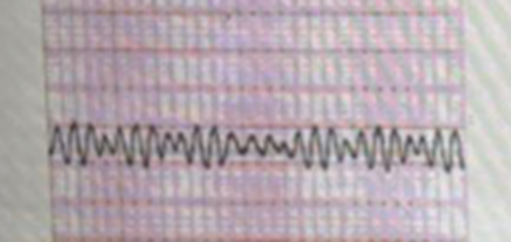A nurse is caring for a client who develops the rhythm below. The client is unresponsive, pulseless, and apneic. Which of the following actions should the nurse expect to do first?

Prepare for defibrillation
Atropine administration
Prepare for synchronized cardioversion
Amiodarone administration
The Correct Answer is A
A. Prepare for defibrillation: Defibrillation is the priority intervention for ventricular fibrillation, as it is the most effective treatment to terminate this life-threatening arrhythmia. Rapid defibrillation can restore a perfusing rhythm, which is critical for survival in a client who is unresponsive, pulseless, and apneic.
B. Atropine administration: Atropine is used to treat bradycardia or asystole but is not effective for ventricular fibrillation. In this scenario, defibrillation takes precedence over medication administration to restore a normal heart rhythm.
C. Prepare for synchronized cardioversion: Synchronized cardioversion is used for certain tachyarrhythmias when the client has a pulse. Ventricular fibrillation requires immediate unsynchronized defibrillation because the client is pulseless and unresponsive.
D. Amiodarone administration: Amiodarone is an antiarrhythmic drug that can be used after defibrillation and chest compressions to stabilize the heart rhythm. However, it is not the initial action in this emergency; defibrillation must occur first to terminate the arrhythmia and restore circulation.
Nursing Test Bank
Naxlex Comprehensive Predictor Exams
Related Questions
Correct Answer is C
Explanation
A) Take the medication with meals:
Inhaled beclomethasone is a corticosteroid, and it is generally not necessary to take it with meals. Oral corticosteroids are sometimes taken with meals to minimize gastric irritation, but this does not apply to inhaled corticosteroids like beclomethasone. The primary concern with inhaled corticosteroids is not related to meal timing but to oral hygiene to prevent side effects like oral thrush.
B) Limit caffeine intake:
There is no direct contraindication or requirement to limit caffeine intake when taking inhaled beclomethasone. While caffeine can have mild bronchodilatory effects, it does not interfere with the action of beclomethasone or exacerbate asthma symptoms. This is not a priority teaching point for the patient.
C) Rinse the mouth after administration:
One of the most important teaching points when using inhaled beclomethasone is to rinse the mouth after each use. This helps to prevent oral thrush (a fungal infection caused by Candida), which is a common side effect of inhaled corticosteroids. Rinsing the mouth with water after administration helps to remove any leftover medication and reduce the risk of infection, making this the most important instruction.
D) Check the pulse before and after medication administration:
While checking the pulse is important for some medications, such as bronchodilators like albuterol, it is not necessary for inhaled beclomethasone. Beclomethasone is a corticosteroid that primarily works by reducing inflammation in the airways, and it does not have a significant impact on heart rate. Therefore, it is not required to monitor pulse before and after its use.
Correct Answer is A
Explanation
A) Wear a dosimeter badge and lead apron when providing direct patient care: When caring for a patient undergoing internal radiation therapy (brachytherapy), radiation safety is the nurse’s priority. The nurse must take measures to minimize radiation exposure by wearing protective equipment such as a dosimeter badge (to monitor exposure levels) and a lead apron (to shield against radiation). These precautions are critical to protect healthcare workers from potential radiation harm while caring for a patient with a radiation implant.
B) Avoid placing a radiation sign at the entrance of the room for patient privacy: Placing a radiation warning sign at the entrance of the room is a mandatory safety protocol when a patient is undergoing brachytherapy. This warning sign informs healthcare personnel and visitors that radiation is present, and it is important for ensuring safety. Patient privacy should not override radiation safety protocols.
C) Alert family members that they should restrict their visiting to 60 minutes at a time: While it is essential to inform family members about safety precautions when visiting a patient receiving radiation therapy, the priority action for the nurse is to ensure their own safety and radiation exposure first. Limiting family visits is an important step to reduce unnecessary exposure, but this is a secondary concern compared to the nurse's direct radiation safety measures.
D) Explain to the patient that she will continue to emit radiation for months after the implant is removed: The patient will continue emitting radiation only for a short period after the implant is removed. The duration of radiation emission depends on the type of radioactive material used in brachytherapy, but it is typically limited to a few days or weeks at most. In most cases, the nurse would explain to the patient that, after the implant is removed, radiation emission will cease.
Whether you are a student looking to ace your exams or a practicing nurse seeking to enhance your expertise , our nursing education contents will empower you with the confidence and competence to make a difference in the lives of patients and become a respected leader in the healthcare field.
Visit Naxlex, invest in your future and unlock endless possibilities with our unparalleled nursing education contents today
Report Wrong Answer on the Current Question
Do you disagree with the answer? If yes, what is your expected answer? Explain.
Kindly be descriptive with the issue you are facing.
